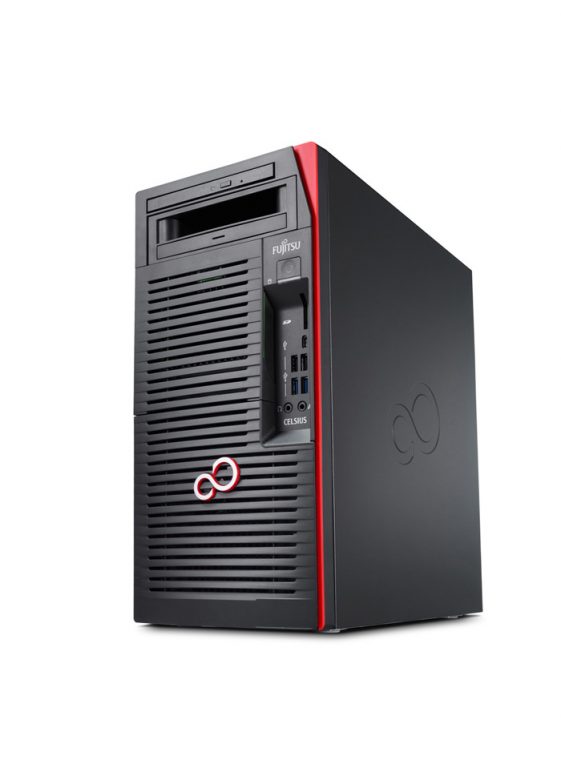This compact workstation not only delivers the goods for 3D CAD but with a powerful GPU, architects and engineers can also take their designs into VR
The workstation landscape changed dramatically early 2017 with the launch of the Nvidia Quadro P4000. This powerful single-slot GPU suddenly gave the traditional Intel Core i7 or Intel Xeon E3-1200 series CAD workstation a new lease of life by giving it enough 3D graphics performance for entry-level professional Virtual Reality (VR) workflows.
Previously, in order to buy a VR Ready workstation from a major OEM, you needed to invest in a more expensive Intel Xeon E5-based machine.
The Fujitsu Celsius W570power+ is a CAD workstation at heart. All the CPU options, bar two, are quad core and the machine can take a maximum of 64GB or memory. But it’s the optional Nvidia Quadro P4000 GPU that gives designers, engineers or architects a new opportunity to take their CAD designs into VR.
But the Celsius W570+power is much more than just a new CAD workstation with a powerful graphics card. The machine, designed and manufactured in Germany, features an innovative 21-litre space-saving micro tower design. It is the smallest ‘VR Ready’ workstation from a major OEM. Equivalent machines from Dell, HP and Lenovo are some 30% larger.
A key part of the design is that the motherboard and GPU span the entire depth of the machine, so both rear and front I/O ports connect to the chassis without cables. There’s also a recess at the rear of the box, so USB, Ethernet and video cables don’t protrude out of the back of the machine as far as they do in other workstations. The recess doubles as a hand hold and certain models have a dedicated front grip, which makes it easy to move the workstation between office and boardroom, for example, for VR or design/review.

The Celsius W570power+ is actually a special edition model of its sibling, the Celsius W570. It features a 400W power supply so it can power the 105W Quadro P4000 as well as more storage.
Incredibly, for a machine of this size, the W570power+ can support up to 28TB of storage. There can be seven drives in total, including three NVMe PCIe M.2 modules. And 2.5- inch and 3.5-inch drives can be swapped out quickly using Fujitsu’s trademark easy rails.
Our test machine came with the popular combination of 256GB NVMe M.2 SSD for operating system, applications and current datasets and 1TB 7,200RPM SATA HDD for less frequently accessed files. The M.2 SSD is on-board, right next to the main system fan, and the HDD is housed in a drive bay at the bottom of the machine. NVMe SSDs are available in capacities up to 1TB, while SATA HDDs up to 6TB.
The processor submitted for this review is the popular Intel Core i7 7700 which, with four CPUs cores running at 3.6GHz (up to 4.2GHz), is well-suited to mainstream CAD work. There are plenty of other choices here, including the top-end quad core Intel Xeon E3-1285v6 (4.1GHz, up to 4.5GHz), right down to the dual core 3.9GHz Intel Core i3-7100, for those on a very tight budget.
The machine gave a good account of itself in our singlethreaded IGES test, exporting our test model from SolidWorks in 99 secs. It delivered our KeyShot render in 669 secs, which is typical of a quad core workstation, but almost five times slower than the 18-core, design viz monster of a machine that is the Scan 3XS WI6000 Viz.
The Quadro P4000 GPU passed our 3D tests in SolidWorks, PTC Creo and Revit with flying colours. The machine also performed well in highend design viz application Autodesk VRED Professional, the AEC-focused game engine viz tools LumenRT and Autodesk Revit Live. However, those working at 4K resolutions may need a more powerful GPU like the Quadro P5000 or P6000.
In VR, using an Oculus Rift, we had a great experience in Autodesk Revit Live. However, as we have found in previous tests with the Quadro P4000, ramping up anti-aliasing on our automotive model in Autodesk VRED Professional made the VR experience uncomfortable. This is not the machine for you if you are heavily into automotive styling.
In summary, the Celsius W570power+ is a great machine for CAD users who also want to support architectural design or product development with real-time design viz or VR. It’s compact, well-built, quiet in operation and, with a price tag of £1,600, also affordable.

Greg Corke
Specifications
■ Intel Core i7-7700 (3.6GHz to 4.2GHz) (Quad Core) CPU
■ 16GB (2 x 8GB) DDR4 2,400MHz memory
■ 256GB M.2 NVMe PCIe SSD + 1TB 7,200 RPM SATA HDD
■ Nvidia Quadro P4000 (8GB) GPU
■ Microsoft Windows 10 Pro
■ 180mm x 304mm x 375mm (w) (d) (h
■ 3 years warranty
■ £1,600 + VAT
If you enjoyed this article, subscribe to AEC Magazine for FREE






